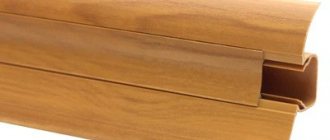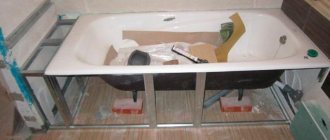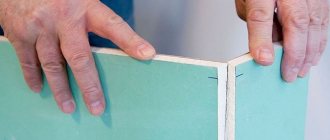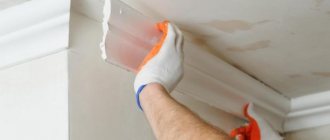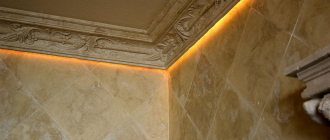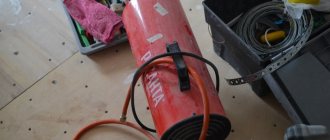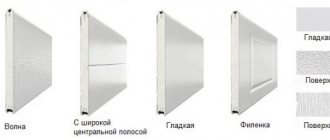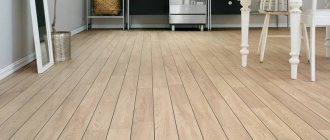assets/from_origin/upload/resize_cache/iblock/9c1/600_450_2/9c161f4366e410e5974abd9c1d0f5e8d.jpg From this article you will learn:
- What types of floor skirting boards are there?
- What types of ceiling plinths are there?
- What material are floor skirting boards made of?
- How to calculate the number of skirting boards
To give a finished look to any interior, it is necessary to cover the junction of the wall and floor, as well as the ceiling and wall, with a plinth. This element has the function of protecting the joint from contamination and moisture. In addition, it is also an indispensable component of decor, helping to make a bold transition from one material or color to another. We invite you to consider this topic in more detail and find out what types of skirting boards exist, how they differ and what they are needed for.
Types of floor skirting boards
Currently, you can see a variety of floor skirting boards on the building materials market. They can be classified according to several criteria, in particular, by purpose:
- Universal profiles. These are most often purchased for finishing both residential and commercial premises.
- Flexible skirting boards are designed for finishing the base of columns, arches, as well as for rooms of complex shapes.
- Fluted profile. Designed for premises where there are increased requirements for cleanliness (hospitals, laboratories, factories). This profile allows you to create a smooth transition between the flooring and the wall.
- Frame or carpet. They help to beautifully decorate the floor, creating a kind of frame consisting of a plastic frame and finishing from the material that is used as a floor covering. This type of profile is very often used in designer renovations.
- Special profile. Able to withstand high mechanical stress. It is usually used in public, as well as commercial and commercial premises.
According to the shape, the profile is divided into 3 types:
- classic figured fillets;
- modern straight planks;
- profiled products.
Take the test
The size may also be different:
- Small skirting boards. The height of such a profile does not exceed 40 mm.
- Standard. Available with a height of no more than 70 mm on the front side. Such moldings are most often used in interior decoration.
- High profiles. The height can reach up to 150 mm. Such a plinth is suitable only in rooms with a high ceiling of 3 m or more.
Usually the length of the baseboard is standard. They produce profiles with lengths from 1.5 to 2.5 meters. The thickness varies from 2 to 2.5 cm; less often you can find moldings 3-4 cm thick.
Installation is carried out in several ways:
|
Fixing with fasteners is the simplest and most reliable way to attach a plinth. The fasteners can be placed on any surface, be it wallpaper, decorative plaster or lining and PVC panels.
Profiles also differ in decoration methods:
- Raw and primed. Such moldings can be painted or tinted with one- and two-component compositions based on oil, acrylic, latex, polyurethane and silicone (glazes, enamels, varnishes, stains, etc.). Typically, PVC and MDF profiles already have a basic white color and do not need to be painted.
- Painted or pigmented profiles. They have a coating that is quite resistant to water and mechanical stress.
- Covered with PVC film. The film allows you to create skirting boards with an imitation of natural materials: wood, marble, granite, etc.
Moldings also differ in the material from which they are made. Let's look at this issue in more detail.
Features of installing aluminum profiles
Self-adhesive plinth requires a flat and dust-free surface.
Installation on clips (also called a base), which is made of aluminum or plastic, requires first installing the base. The base can be attached with self-tapping screws or liquid nails. With this type of fastening, the base cannot be removed during repairs without damage.
Important! We must not forget that during installation the product fits into the corners by 5 mm, and into the plugs and connecting element by 2-3 mm.
The profile is placed on the installed base and pressed with your fingers. You should hear a click – the baseboard is installed.
Types of floor skirting boards depending on the material
If you know what material the skirting boards are made of, then choosing the required option will not take much time. Let's start the review with the material from which the profile is made. This will help you immediately determine the type and size of the floor plinth.
Skirting boards made of wood and using wood
- Solid wood and veneered plinth
The name “wooden” can mean a profile made from either solid hardwood or solid, cheaper pine wood, and also includes plywood baseboards covered with veneer. If you plan to paint the baseboard, it is not recommended to purchase a profile made from solid expensive wood.
Moldings made from valuable wood are purchased to decorate floors covered with wooden parquet. Pine skirting boards are inexpensive, but such a profile is not resistant to damage.
The wooden profile is an environmentally friendly material, which undoubtedly belongs to its advantages. However, do not forget that this type of baseboard can be easily damaged by heavy furniture, causing dents to appear on the surface. And with pine plinths and veneered moldings, you need to be especially careful during installation: one wrong move and the panel can crack.
A plywood profile is much stronger than a solid one, and all this is due to the structure of the material. As you know, plywood is made by gluing together several layers of wooden plates. Moreover, the direction of the fibers of the new layer is perpendicular to the direction of the fibers of the previous one. Thus, the structure of the canvas is quite solid compared to a solid profile, so it is not so easy to damage the panel.
But there is also a big disadvantage: layers of plywood are most often glued together with compounds containing formaldehyde and phenol. Therefore, it is worth buying a safer type of skirting board, paying attention to the markings. Thus, plywood products labeled FBA contain natural albumin-casein glue. The next type of plywood is designated as FC, which means that the profile is assembled using urea glue. Next comes plywood marked FB on bakelite varnish. The most toxic type of plywood is designated by the letters FSF, which identifies the resin phenol-formaldehyde in the adhesive composition.
Experts do not recommend using wooden profiles in bathrooms, as they are very sensitive to changes in humidity. But in general, if the operating conditions are suitable, the baseboard will serve for many years.
- MDF profile
This profile is not recommended for those people who like to rearrange the furniture in the room from time to time. Many people avoid this type of plinth.
MDF is a medium density fiberboard. The profile is made from wood flour, which is pressed and bonded using urea resins modified with melamine. Manufacturers, of course, are in a hurry to assure everyone that the formaldehyde released by resins does not exceed certain standards.
The main reason for its popularity is the wide range and affordable price of products. The film that covers the profile has a wide color palette, so it is very easy to choose the desired color for any floor covering. There is also a painting option available. The MDF profile is easy to cut and install. But, like wood, these panels are not resistant to high humidity, so they cannot be used in bathrooms and kitchens. Such moldings are created exclusively for rooms with a constant dry microclimate.
- Moldings from LDF
Unlike MDF profiles, LDF profiles are significantly lighter, since they have a lower material density, and accordingly, they are much easier to saw. In addition, environmentally friendly resins are used in the production of this type of skirting boards. Instead of wood waste, low-density wood-fiber panels are made from pine and eucalyptus fibers, which are specially grown for this purpose.
There are no particular differences in the wear resistance parameters of MDF and LDF skirting boards. These profiles equally do not tolerate frequent wet cleaning of the floor.
There are several types of fastening LDF plinths: with self-tapping screws, glue, clips, and installation on rails.
- Profile made of “liquid wood” material
Not so long ago, this type of plinth appeared on sale. The material resembles in its properties MDF/LDF profiles and plastic moldings at the same time.
Panels are produced from various waste materials that contain wood components: sawdust and wood dust, straw, paper and even nut shells. The raw materials are ground into flour, and then it is mixed with various synthetic additives and dyes. Most often, the binder is polyethylene, as well as polypropylene or polyvinyl chloride.
Skirting boards made of such material can take any shape in a liquid state. Thanks to the content of a special additive or simply by heating, it is possible to bend the profile for installation on rounded walls. Typically, such skirting boards are veneered, laminated or painted.
- Cork plinth
This is the name of a profile that is made from cork chips or covered with a layer of cork.
Experts note that this is the most environmentally friendly material. In addition, this type of plinth can be easily bent along a small radius. The cork profile, due to its porous structure, easily adheres to the wall and holds up well for a long time. Of course, there are not only advantages, but also disadvantages of this type of plinth.
A significant disadvantage of this material is its low resistance to mechanical stress. It can burst during installation even with slight force. And the veneered plinth is easy to scratch even with a fingernail. Another big drawback is that the material is not moisture resistant.
In addition, cork plinth is not appropriate in every room due to its specific appearance. And the well-known useful qualities of cork (low thermal conductivity and noise insulation) are neutralized, since the area of the plinth is insignificant.
Plastic plinth
Experts pay special attention to the fact that plastic must not be heated!
This is due to the dangerous property of PVC (polyvinyl chloride) - when heated, it releases toxic fumes into the air, which destroy nerve cells and cause cancer. Therefore, the plastic profile can only be installed in rooms where the air does not heat above 600.
In the event of a fire in a room with plastic baseboards, the air is instantly saturated with a full set of chemical warfare agents. Only in its solid state is polyurethane inert.
- PVC and polystyrene profile
Most people associate PVC profiles with Soviet plastic skirting boards with plugs, which did not bring much aesthetics to the interior. But all this remains only in memories, since a lot of time has passed and a lot has already changed. Modern PVC skirting boards can be beautiful.
The big disadvantage of PVC profiles is the fact that they are quite fragile. Therefore they have low cost. But at the same time, this type of skirting boards can be attached to walls with slight irregularities - a PVC profile will hide these flaws well.
Skirting boards made of polystyrene differ significantly from polyurethane ones, although manufacturers are most often silent about the material from which the products are made. Polystyrene allows you to make an impact-resistant profile.
This material is stronger than PVC, but more fragile than polyurethane. Polystyrene skirting boards are the most economical option compared to other types of plastic profiles. They are lightweight, do not allow moisture to pass through and do not absorb odors. But still, like any other plastic, they strongly attract dust.
It is also worth remembering that polystyrene is not resistant to ultraviolet radiation, even if the manufacturer has added UV stabilizers to the composition. Over time, in a room on the sunny side, such skirting boards will begin to turn yellow and even crack.
Also, for several months after release, polystyrene releases volatile technological compounds. Therefore, it is important to find out the release date of the plastic panel when purchasing.
Installation is carried out using self-tapping screws, glue, clips, and also attached to special rails.
- Polyurethane skirting
This type of plinth is popular, largely due to its low cost.
A polyurethane profile is much stronger and harder than a wooden one, and it is also significantly lighter. But, despite its water resistance, it still does not accept sudden changes in air humidity. The main advantage is that such a plinth is easy to paint, since the surface is already prepared and there is no need to additionally sand it and then prime it. You can only paint with water-based acrylic or latex paint, otherwise the surface of the baseboard will begin to dissolve.
The plinth can be quite flexible (up to 30 cm in radius) if the composition includes rubber. This type of plinth is also called rubber.
And yet, despite all the advantages, the polyurethane plinth has a drawback - the profile gradually shrinks transversely and linearly. No specialist can accurately determine the percentage of shrinkage. Perhaps this is known only to production technologists. But it is known from experience that over time, cracks will inevitably form at the joints of the profile. Even special joint adhesive will not help during installation. Therefore, on occasion, you will have to fill the cracks with a special filler, which, fortunately, can be purchased.
Polyurethane is a strong dust magnet. This ability can be neutralized by covering the surface of the baseboard with paint.
The affordable price is also explained by the fact that polyurethane skirting boards are produced by many domestic enterprises.
- Duropolymer molding
Relatively recently, skirting boards and stucco molding made of duropolymer appeared on the building materials market, so this type of profile is not often seen on sale. The cost of such panels is relatively low. Duropolymer is more difficult to cut, since it is much denser and heavier than polyurethane.
A small range of shapes and profiles significantly reduces consumer demand. Just like other types of plastic skirting boards, duropolymer moldings attract dust. Therefore, it is advisable to paint such a skirting board immediately after installation.
Experts note the environmental friendliness of this material, as well as its high strength and lack of shrinkage. Such skirting boards are prepared for painting and practically do not differ in appearance from polyurethane ones. However, they are leaders in wear resistance. In addition, there are flexible varieties of this profile.
The requirements for paint are exactly the same as for polyurethane skirting boards - paints must be water-based (acrylic or latex). The surface of duropolymer panels does not require sanding or priming.
Duropolymer is resistant to moisture, does not absorb odors, and neither fungus nor mold takes root on it.
Recommended articles on this topic:
- Eco-friendly materials for interior decoration
- Stages of renovation in an apartment
- Turnkey cosmetic repairs
Ceramic or stone skirting boards
A plinth made of ceramic tiles or porcelain stoneware is made if tiles are laid on the floor. There is a wide range of specially made ceramic panels available for sale. But most often, in order to save money, the baseboard is made from the same tiles from which the floor surface is laid.
An expensive finishing material is a marble profile. But its advantage is obvious - it is very durable and will serve for many years without losing its qualities and without changing its appearance.
Metal skirting boards
A rare type of decorative plinth. This profile can be used as a design element or when a special need arises when the plinth must withstand heavy loads. But still, a metal profile is appropriate not only in public places, but also in residential premises. In the West, you can often see decorative metal cornices, which are designed to complete the overall composition of the room. And the style is not always industrial.
This type of plinth can be installed for decorative purposes both inside and outside the building. The material allows you to repeat any surface shape, it is quite strong and durable. In addition, you can do without corner elements, since the metal can be easily bent in the desired direction.
The only thing is that it can be difficult to find beautiful plugs and connecting elements, which is undoubtedly a problem. But still, a lot depends on the model of the plinth.
In addition to decorative metal cornices, which are designed to decorate and disguise minor imperfections in the interior, there are profiles that carry a significant power load. Metal plinth for drywall is just such an example.
This type of baseboard is attached to the wall in order to support the drywall underneath. In this case, the molding is flush with the wall or recessed into it. This creates the effect of “floating walls”. This effect can be enhanced by placing LED lighting in the baseboard. This design can also be decorated with planks made of wood, marble, tiles and any other material.
Accessories
Manufacturers produce fittings for installation for aluminum skirting boards, similar to fittings for plastic profiles: external and internal corners, side plugs (right and left are supplied in pairs), connecting elements. The fittings are made of aluminum or durable plastic in the color of the baseboard.
Types of ceiling plinths
Galtel is the name given to ceiling plinth. Let's look at the types of skirting boards for the ceiling. In a general sense, fillets perform 2 main functions:
- Practical. They help to mask defects at the junction of walls and ceilings and create the impression of geometric perfection of the room. Skirting is indispensable if repairs are carried out independently, without the involvement of specialists.
- Decorative. Undoubtedly, the ceiling plinth gives the room a complete look, and can also become an additional element in the design. For example, fillets with a relief pattern are chosen for rooms in a classic style, while straight and narrow moldings without a pattern are suitable for high-tech rooms.
Different types of skirting boards are presented in the photo in this article. There are several main signs by which you can easily choose the required profile for the ceiling.
- Material from which fillets are made
Tree. Skirting boards made from this material are mainly used to create classic designs. They look very impressive, aesthetically pleasing and even solemn.
Gypsum. Plaster cornices can be seen in ancient buildings. Currently, a similar profile is used in expensive interiors to give the appearance of antiquity.
Polyurethane. Most often, fillets made of this material are installed in rooms in a classical style, since they are difficult to distinguish from gypsum stucco. Various rosettes, columns, and consoles made of polyurethane will help create an atmosphere of antiquity.
Polystyrene. In terms of its strength and flexibility, this material is a cross between polyurethane and foam skirting boards. Using the injection method, flexible and durable fillets are made from polystyrene for finishing sloping surfaces.
PVC. Such cornices are appropriate if the ceiling or walls are covered with plastic panels. Most often they are installed in rooms with a constantly changing microclimate, such as a bathroom, balcony or corridor. The ceiling takes on a neat appearance thanks to the fact that the panels can be inserted into the cornice.
Styrofoam. The most mechanically unstable material. It is recommended to place foam fillets in the upper and middle parts of the wall in the form of a decorative border.
- Dimensions of ceiling plinths
The type and size of skirting boards depends on the area and purpose of the room.
Narrow (10–15 mm) are suitable for small rooms with low ceilings, used for a laconic design.
Medium (60–150 mm) are recommended for ceilings with a height of 2.5–2.7 meters.
Wide (160–350 mm) are used in finishing rooms with high ceilings (from 3 m and above).
- Appearance Options
With pattern. Fillet with a pattern can become a special element in the interior, attracting everyone's attention. On sale you can find a large number of ceiling plinths with a three-dimensional pattern. Therefore, you can easily choose a suitable cornice.
Without a pattern, but with relief. Such a molding can create an atmosphere of comfort and make the design of the room elegant and unique, while the role of the plinth may seem invisible at first glance.
Smooth, straight. Suitable for all modern interiors, besides, such a baguette will look organic in rooms designed in a classic style.
All these types of skirting boards are also suitable for suspended ceilings.
Like any other item, ceiling plinth has both positive and negative aspects:
- Environmentally friendly materials, such as plinths made of precious wood or marble, are very expensive.
- Plaster and some plastic cornices, due to their rigidity, can be used exclusively in rooms with ideal geometry, performing only a decorative function.
- If you choose a material with good flexibility, then most often foam curtain rods meet these requirements. But they have a significant drawback - when burned, foam releases toxic substances into the air, just like most plastics. Over time, the baguette turns yellow under the influence of ultraviolet radiation. And, for example, PVC retains its original color.
- The popularity of plastic skirting boards is explained by the fact that their smooth and even surface is easy to clean. But during installation, problems arise with attaching the last panel.
It is necessary to take into account the conditions in which the decorative plinth will be located. The atmosphere in the room depends on the design of the cornice. For example, a wide baguette with a pattern is perfect for spacious rooms and, on the contrary, will be inappropriate in a small room, where it will look bulky and pretentious. Narrow fillets also look ridiculous in large halls. It is very important to evaluate the possibilities of the room and weigh the pros and cons before purchasing a specific (material and width) plinth.
- Skirting boards made from extruded raw materials
Such fillets are made by foaming the extrusion method of polymeric materials such as PVC, polystyrene, polyurethane. In this way, the product is particularly light, which undoubtedly helps in work.
This type of skirting boards is produced in three ways:
- foaming inside;
- free foaming;
- combined method.
What is the internal foaming process? The mold is filled with molten extruded raw materials, as a result, pores are formed in the material. The mass is cooled, thanks to which the substance hardens and stops increasing in size. In the finished baguette, it is necessary to remove pores from the outside, so they are smoothed out at the calibration stage. Polystyrene and polyurethane make it possible to produce complex reliefs and shapes in this way.
Free foaming is used to create the simplest fillets. The material used is PVC. The calibrator allows you to carry out the entire process from foaming to cooling the substance inside. Therefore, the baguette turns out smoother and tougher.
The combined method allows the foaming process to be carried out not over the entire area of the mold, which is why complex convex patterns are obtained.
Most often, extruded baguette is glued at the junction of walls and ceiling. The designers came up with an interesting solution, using the profile not only to finish the junction of the ceiling and wall, but also placing another cornice line at a distance of 20–30 cm from the top. You can also decorate the lower cornice with LED lighting, which makes the interior unique and impressive.
Also, this type of skirting boards can serve as a decorative border, designating certain zones, and not only serve to frame the line connecting the ceiling and walls, as is traditionally believed. You can, for example, create a kind of frame on the wall for a large photograph. Here you need to use your imagination and choose the appropriate material.
How to choose
Skirting boards cannot act as an independent interior detail. They are always chosen with an eye to some larger element that is located next door. For example, they focus on the color of the door, window, furniture, and floor shade. The material also matters. Wood is universal and can be combined with any walls and floors. Budget plastic is suitable for linoleum, laminate and carpet. Ceramic and stone skirting boards look organic only with marble, granite and tiles.
Match the color of the walls
A plinth matching the color of the walls allows you to erase or emphasize the boundary between them and the floor. In the first case, so that the surfaces do not merge completely, select a “belt” that is a shade lighter or darker. This technique is a favorite among designers, since the option of combining tones close in the spectrum is considered a win-win.
In rare cases, walls, door frames and baseboards are selected in the same color. The solution is very fresh and extravagant, therefore suitable for bold modern styles. To emphasize the boundary between the floor and the wall, choose either a neutral shade of the baseboard or a bright one. The latter is rare, since in the color scheme of the element they still give preference to nut, beige, chocolate and coffee with milk. It is not recommended to choose a baseboard that matches the color of a wall decorated with a covering with colorful patterns. The boundary between the floorboard and the floral wallpaper should be strict and neat.
Match the color of the floor
According to traditional canons, the plinth is selected to match the shade of the floor covering. Ideally, it should be a couple of shades lighter or darker, depending on the color transition to the wall. The combination of the same shade is considered a win-win
In this case, it is not so important whether the baseboard is combined with the tone of the wall covering or window and door openings. Everything above should be combined with the fillet, and a neat, plain bottom will remain aside
Match the color of doors and windows
Designers recommend choosing baseboards to match the color of door and window frames only if they are made of wood. This element will help to gently integrate into the interior openings of a different shade that look unbalanced in the overall palette of colors. For example, in a room with dark flooring and walls, white doors will find support in the form of a baseboard of the same color.
White edging in the interior
White plinth ennobles the interior, making it more refined and elegant. It is universal and organically fits into any stylistic solution. A neutral color allows you to harmoniously add white doors or windows to a dark environment. With such a plinth, any interior will look airy and light. White edging will highlight the high walls. The effect of this technique is doubled if the ceiling is decorated with the same fillet. Although the white baseboard is new, it seems like it was created for a classic style. The element will add a refined touch to the luxury of the interior. However, it is worth considering that light-colored edging will have to be washed systematically, since the surface is easily soiled, and the floor is not the cleanest place in the house.
Colored contrasting floor frames
Contrasting colors in baseboard panels are a bold innovation in recent years. They are ideal for extraordinary, creative interiors decorated in modern styles. Since the flooring is usually done in neutral colors (shades of brown, black, gray), skirting boards are selected to match the furniture and individual decorative details. In strict classics, such an option is difficult to imagine, but fusion, futurism, eclecticism, and ethnicity, which are flexible in relation to innovations, will calmly accept such a bright experiment. A living room in a mixed style with an orange-violet color scheme will be emphasized by a defiant lilac baseboard. A dark environment will be enlivened by a contrasting strip of red, yellow or green. Eye-catching black and blue panel curtains against the background of light walls and a neutral floor will find support in the blue baseboard.
Calculation of ceiling and floor skirting boards
Skirting for floor
Behind the apparent simplicity lies an inevitable error in the calculation when they forget to include in the calculation places that are invisible at first glance, such as:
- doorways;
- arches;
- niches;
- other hard-to-reach places.
Using examples, we will look at how the calculation should be performed, and using them as a guide, you can easily make the necessary calculations yourself.
1 way. To quickly calculate, we will need a calculator. First, let's find the perimeter of the room. We measure the length of the walls and add up the indicators. One plinth element has its own standard length, depending on the model. Having chosen the profile model and found out the length, we proceed to the calculation. For example, if a room has a perimeter of 21 meters and a baseboard length of 2.5 meters, then 21 should be divided by 2.5. In our case, it will be 8.4 - this is how many elements will be needed to finish the entire perimeter. The fractional number is rounded up, that is, up to 9 planks of 2.5 meters each.
Method 2. It also happens that the profile is sold in the form of a long strip, and it is possible to cut the plinth right in the store into pieces of the required length. But it’s still worth cutting the material with a small margin (about 5 cm), so that when installing the profile on site, it won’t turn out that the plinth is not long enough.
Flexible plinth requires special attention during transportation. It may become easily deformed if shipped at temperatures higher than recommended. And wooden and veneered skirting boards can easily be scratched if delivered carelessly. Polyurethane ones need to be protected from chipping. However, plastic panels also require careful transportation, although any of the blocks can be replaced without any problems.
Ceiling plinth
The molding for the ceiling should cover the lower part of the wall well in order to hide possible stains; this is important for all types of baseboards. The advice is especially relevant if the walls are painted with light-colored paint.
You need to choose the material depending on the area of the room where the fillets will be attached. It is important to remember that the higher the ceiling and the larger the room, the wider the cornices should be. A narrow baguette can look poor and be completely lost against the background of the interior of a large room.
There are indicators developed by the experience of specialists that will help determine the parameters of the ceiling plinth.
- If the ceiling height is up to 2.5 meters, and the room area is from 15 to 23 m2, then the fillet width is recommended up to 9 cm.
- If the ceiling height is 2.7 meters and the area is from 15 to 23 m2, then the width of the plinth can vary from 9 to 14 cm. A room with an area of 23 m2 requires finishing with a profile with a width of 15 to 21 cm.
- The ceiling height is from 3 m and higher, and the area is from 15 to 23 m2, then the width of the baguette is allowed from 15 to 21 cm. Accordingly, the larger the area of the room, the wider and more complex the decorative baguette can be.
Just as when calculating the baseboard for the floor, the number of baguette strips is determined if the perimeter of the room is divided by the length of the strip. If the result is a fractional number, it should be rounded up. Typically the length of the ceiling plinth is 2 m.
Installation is quite simple, you just need to be careful and attentive at the stage of cutting the material, and also make sure that the baguette does not accidentally break. Then additional difficulties arise in eliminating the resulting defects. Therefore, experts recommend purchasing an extra panel in reserve. Most models of ceiling plinths are inexpensive, so purchasing an extra part will not burden your budget.
Dimensions
Plastic is one of the most flexible materials, allowing you to make products of any shape and size. Therefore, a plastic floor plinth can be of any cross-section and size, but it still has certain limitations that are related to the practical side. In general, plastic skirting boards are produced with the following parameters:
- height 50-120 mm;
- thickness 10-26 mm;
- length 2000-25000 mm.
Some types of plastic floor skirting boards with dimensions
These are the most common sizes, but there are some variations. For example, there are wider ones at the bottom - about 50 mm. They are needed if the gap between the wall and the floor covering is slightly larger than what the technology requires.
Technologies do not stand still
Technologies are developing and this is largely due to complex architectural styles and the rejection of sharp corners in the interior. Soft rubber and flexible floor plinths have already managed to occupy their niche in the renovation of premises. These are polyurethane products with the addition of rubber in different proportions, which are able to bend around any radius, but flexible skirting boards have limitations; it can be bent to a minimum radius of 150 mm.
Flexible floor skirting boards for curved structures are also available in plastic versions. The wood industry also offers radius floor skirting boards, curved ones that can be ornamented. Each manufacturer produces its own line of radii, the choice is limited, and it is not always possible to choose the right size; in this case, the plinth can be made to order.
In fact, the variety of profiles does not end there; expensive and exclusive floors have their own skirting boards made from the same material. For example, for cork coverings, cork profiles of different configurations are made, since the material is plastic, this line also has its own flexible analogues.
Radial and curved elements are available in skirting boards made of all materials
In conclusion, we will say that if the walls in the room are flat (or almost flat), then the installation of the plinth is carried out after facing the walls, but if the surfaces are clearly curved, then it is better to install the plinth before finishing, so you can fill the gaps between them, and the defects will become almost invisible .

